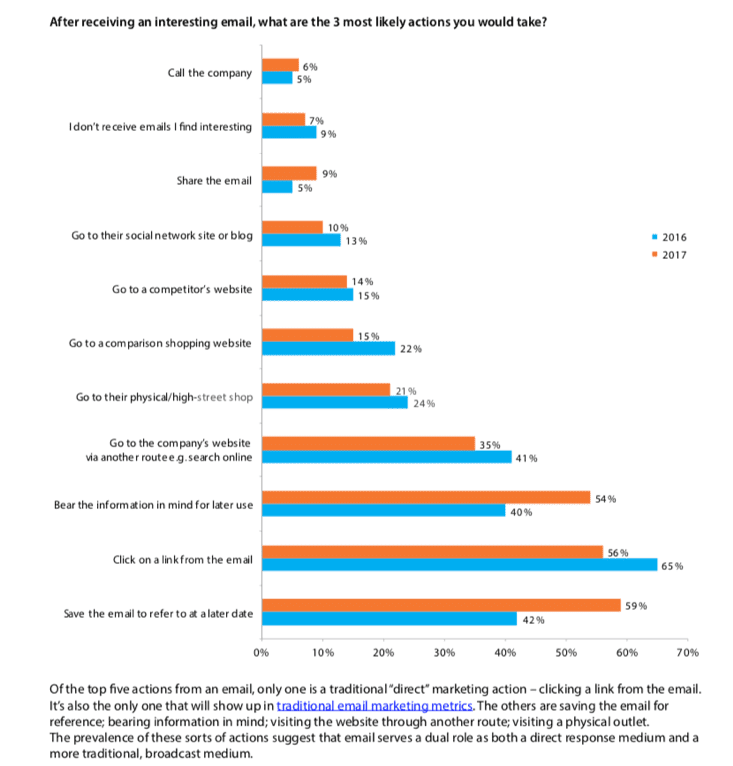In the 20+ years since email proved itself as a worthy channel for messaging and marketing, we still don’t have a single set of guidelines that’s accessible for all, for the best way to conduct business with it.
For many of us, “best practices” fill that knowledge gap.
So, we latch onto these concepts when we need to solve problems. The solutions become trends (because everybody’s doing it), and boom! Email urban legends are born.
That’s not to say that all “best practices” have such murky origins. My problem is with generally accepted “best” practices that don’t stand up to closer examination and rigorous testing that works for every brand.
I’m not saying that the three email urban legends below aren’t applicable for some, they’re just not applicable for all, as is often touted.
3 Email Urban Legends Posing as Best Practices
- Double opt-in is the best way to build a high-quality email list.
- Delete your inactive subscribers or customers to maintain list quality.
- Short subject lines work best.
Right about now, you might be thinking, “Wait! What? That’s not what the boss/my co-worker/a conference speaker said.”
I understand your confusion, but hear me out in the next section, and hopefully, I’ll persuade you to test these out to find if they work for you or not.
1. Double opt-in is the best way to build a high-quality email list
Double opt-in (DOI) is the appendix of the email industry. It served a purpose once, back before ISPs had strict permission requirements, when scammers and spammers hijacked millions of email addresses and made up millions more to reach inboxes.
Today it’s more of a “nice to have” than a “must do.”
Back then, many ISPs and some email service providers, required commercial email senders to use DOI to use their platforms as it played a very important part in deliverability.
In days of old, deliverability by ISPs was based on whitelisting, and you could only be added to a whitelist if you could prove DOI. But deliverability has come a long way since then and we’re no longer reliant on whitelists and DOI.
Today, we have more reliable methods to identify legitimate senders and validate email addresses, like Kickbox and others. Plus, most countries have laws mandating consent to receive commercial email (the United States and India are a couple of the exceptions).
On the business side, I’ve personally witnessed DOI costing marketers up to 60% of potential subscribers. This process can hamper database size, confuse subscribers, deliver a poor customer experience and hurt revenue.
DOI might make sense for some marketers—if they’re in highly regulated industries like finance or government, or if they’re based in or mailing to countries that prefer DOI.
For instance, DOI is not a legislative requirement in Germany; however, based on case law established by the Federal Court of Justice, it’s recommended for evidence purposes.
Beware, though, there is no legislation (that I’m aware of) which mandates DOI to be used, including CASL and GDPR, which many mistakenly believe they do.
So choose wisely. Don’t go with DOI just because someone told you it’s the best practice. Pick the format that best serves your business objectives as well as your customers’ interests.
2. Delete your inactive subscribers or customers to maintain list quality
When this practice is applied generally to all brands, it becomes more of a “worst practice” than a “best practice.”
In short, it can kill off business and should not be applied ‘generally’ to all businesses, however, it may be relevant for some.
The main reason being, email messages can nudge consumers to take many actions that don’t get attributed back to email, as this chart from the UK DMA’s Consumer Email Tracker Report 2017 shows:
Yes, you read that right. Out of the top 8 actions a consumer takes, only one will be attributed to email, and it’s not even the top action!
Email is a push channel and it often starts the consumer on a journey to purchase, albeit not always in the desired journey route, such as clicking through the email.
Right about now you’re probably wondering about the other engagement metric—opens— and the role it plays here.
I’m sure we all know by now that opens are reliant on the recipient downloading an invisible pixel in order for ESPs to be able to track that they’ve ‘opened’ the email.
Because of this and because not everyone has images set to download by default, opens are essentially an unreliable metric.
For example, if you’ve designed your email to gracefully degrade and not be reliant on images downloaded (which is recommended), then the recipient can read your persuasive copy and details of your fabulous offer without needing to download images. They then can simply head off to your website to take advantage of this offer.
Or, if you do a great job with your subject line and let them know the offer within it, then they don’t need to open the email but can go straight to the site.
So, the danger here is that unless we have a single customer view of our database (and not many of us do), then we could be cutting off those customers who are ‘nudged’ to the site to buy, but ‘appear’ to be inactive on email.
And this cutting off could have dire consequences on our revenue.
You have many ways to identify and win back lapsed customers without getting out the carving knife:
- Factor in your buying cycle. Some experts will tell you to drop non-responding addresses as early as 90 days after opt-in. That’s pretty harsh if your products have a long buying cycle. Study the buying habits of your inactive customers—they might be more active than you think.
- Look for activity in other channels. Can you identify whether your inactives have been browsing or buying on your website?
- Start a win-back program as soon as you begin to detect inactivity.
This is not a topic to take lightly, and due diligence is necessary to determine which approach best suits your brand and your brand’s goals.
Then fully armed with this knowledge, you can make an informed decision, rather than following advice from someone who does not have the responsibility of delivering upon your brand’s goals, as you do.
3. Short subject lines work best….for everyone….all the time
As a trainer, speaker and consultant, the most common question ever asked of me is, “Should my subject lines be short or long?” This question and its associated urban email legend arise from two contributing factors:
- Some email clients, like AOL & iOS, truncate subject lines in the inbox between 35 and 60 characters.
- Shorter subject lines generally drive higher open rates.
So, shorter subject lines work best, right? That’s the myth, but here’s the reality:
Phrasee discovered that subject line length accounts for just 0.1% of email open rate variance. Therefore, the question above is actually the wrong question to be asking.
The correct question is: “Should my subject lines be generic or specific?”
The reason being, in general, generic subject lines appeal to a broader audience, which leads to higher opens; the more generic they are, the more people can read into them what they want to.
However, more specific subject lines qualify leads in the inbox. That is, they appeal more to the people who are more likely to convert from the open. Fewer people open, but more of those that do open click through to the website.
When testing a subject line for a cart-abandonment email, this brand compared two subject lines in an A/B split test sent over four weeks:
- A. “Reminder: Items saved in your cart – Shop now for an extra 10% off“
- B. “Come back and save an extra 10%“
The more generic subject line B had a 10.5% higher open rate. But the more specific subject line A increased orders by 21% and revenue by 35%.
It might seem logical to write shorter subject lines, so the inbox doesn’t lop off crucial information—but that doesn’t mean it’s right for your email program.
Using the open rate as your KPI is fine if your objective is to reach as many people as possible.
But, if your objective is to gain conversions, don’t stop at the open rate. Test it. Test generic subject lines against specific subject lines to see which help you to achieve your objectives. You might be surprised.
Wrapping Up
As Chris Goward writes in his book, You Should Test That!, best practice recommendations often don’t consider a brand’s unique business environment, goals and target audience. It can be intimidating, too, to turn your back on conventional email wisdom.
Always see what works best for your email program before adopting anyone else’s recommendations—even mine!
When you know what works best for your email program and audience, with its quirks and unique needs, you can avoid email urban legends and plot your course for the best outcomes.
































